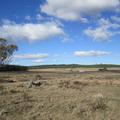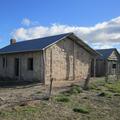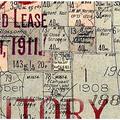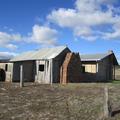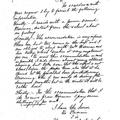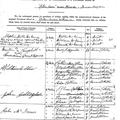< Early Canberra Government Schools
Kowen School [1875 - 1913]
Previous Name/s: 'Felled Timber'(1875-1878)?
On 3 May 1881 Frederick Campbell, JP of Duntroon, lodged an application for the establishment of a school at Kowen ('Glenburn' was crossed out on the application and replaced with 'Kowen'). Those who undertook to send 18 children were Stephen Walter McNerny (three boys aged 8, 6 and 4 years), Martin Campbell (a girl ward aged 11 years), William Collier (six girls, including a set of twins, aged 13, 11, 9, 6, 6, and 5 years), John Gallagher (two girls aged 12 and 6, and two boys aged 10 and 9 years) and John McInnes (three girls aged 12, 10 and 7, and one boy aged 8). The application was successful.
Some residents asked that the teacher be female and aged 21 or over because a number of grown children aged 14 to 16 who were not included in the application would be attending in the first 12 months. Isobella Ann O'Neill was appointed as the first teacher and the Kowen Provisional School opened in July 1882. She initially boarded with the Harmans in a two-room hut 'about one furlong' north of the school, sleeping with Mrs Harman and the baby, at a cost of 7/- a week.
The school was raised to Public status in December 1882 and in June 1883 two acres of land, Portion 70 in the Parish of Amungula, were permanently dedicated as a Public School site, and Portion 69 (within which Portion 70 was located) was temporarily reserved for school purposes. The local residents provided the building and furniture for the school. By inference from information on school maintenance, the school was of vertical slab construction, not pisé, had a fireplace, glass windows, and was lined and floored. The roof was possibly of bark or of iron. In 1891 minor repairs were carried out. In 1898, at a cost of £14 10s, two pit toilets with skillion corrugated iron roofs were erected and a 400 gallon (about 1800 litres) ship's tank was provided, placed on a stand and connected to the roof. In addition, repairs were carried out to the door, windows, fire- place and floor.
In February 1901 John McInnes wrote to the Minister for Works requesting the erection of a new building. After being rejected he wrote again in May 1901. His letters tell in simple, straight- forward terms that the school was not fit to accommodate children because they had to put their overcoats on to keep dry in wet and windy weather. It was not even fit to stable the school inspector's horse. It was to no avail. The outcome of John McInnes's plea was that small repairs costing 17s 6d were carried out in June 1901, and in July 1904 more substantial, but still small, repairs costing £2 were carried out.
The school certainly had its ups and downs. After Isobella O'Neil resigned at the end of August 1885, the school had a succession of teachers, the attendance of children was irregular and their work suffered as a result. The school was under threat of closure in 1890 because of low attendances and it actually closed for a short period when no teacher was available. In May 1890, in an effort to revive the school, the District Inspector got from one of the parents a list of names of 16 children whose regular attendance would be guaranteed. John Gallagher guaranteed to send two girls aged 13 and 10 and a boy aged 10, Luke Colverwell junior a girl aged 11 and two boys aged 9 and 6, Thomas Harman 3 girls aged 8, 5 and 3, William Cooper a girl aged 3 and a boy aged 7, and John McInnes two girls aged 12 and 6 and three boys aged 10, 8 and 8 (one of the girls aged 12 and one of the boys aged 8 were Horrocks children who were living with his family). The school was reopened after the service of a suitable teacher was obtained, on the understanding that if a minimum average attendance of 12 pupils was not maintained, the school would be closed.
I have seen only one reference about students who actually attended the school. Gallagher (Gallagher N.J. The long travail, Canberra,1987, p57) says that Sydney Edward Gallagher (b1879 - one of the children on the list mentioned above) attended the school with the McInnes, Colverwell and Cooper children. In an interview with Babette Scougall, Harold Tuson - who lived at Kowen homestead for three and a half years from 1926 - is reported as saying that when the Goulburn to Queanbeyan railway was being built (the railway reached Queanbeyan in 1886), the school had 70 pupils (Canberra & District Historical Society Journal:1989) In the light of the information set out above, I doubt the accuracy of Mr Tuson's statement. In October 1906, the teacher reported that the average attendance for the September quarter was 6.5 on an enrolment of 10. The school was closed that month although a subsidised school operated in the building in 1908, 1912 and 1913.
The school site is about 300m north-west of the Glenburn homestead, which is still standing. There is no remaining physical evidence of the school. A dead pine tree on the southern side of Charcoal Kiln Road and the remains of another near the sheep loading ramp and yards to the north are all that remain of those that formerly ringed the school. In NSW pine trees were often planted near schools to provide both wind protection and summer shade.
[This account is drawn from Colin McAlister's impressive booklet on 'Twelve historic sites in the Glenburn and Burbong areas of the Kowen Forest, NPA ACT, Canberra 2007. He notes that his information about the school was drawn mainly from Gillespie (1999, p55) and State Records NSW 5/16510.4. We gratefully acknowledge Colin McAlister's fine work on the Kowen district and permission to edit for reproduction here].
"The 1880s were the heydays of Kowen. A school was needed; and [in 1881] Fredrick Campbell lodged an application for its establishment in the Glenburn area. Five families first undertook to send 15 young students to the school. Of these, William Collier sent his six children. Kowen Public School continued until October 1906 but a subsidised school operated in the building until 1913. The road to this school branched off from the Queanbeyan/Bungendore Road, crossed the Molonglo and skirted Collier‟s stone cottage immediately to the west."
from Eric Martin & Associates. William Collier's Stone Cottage (Kowen). Conservation Management Plan, p.3
[Note : Official records state that the school opened in 1875 and was initially called 'Felled Timber']
Location Map
Related Photos
Teachers
- O'Neill, Isabella Ann
07/1882 - 12/1885 - McClurg, Alice
01/1886 - 08/1886 - Kennedy, Mr Thomas H.
09/1886 - 06/1887 - Smith, Fannie
07/1887 - 05/1890 - McManus, Ellen ('Nellie')
07/1890 - 03/1896 - Synnott, James
04/1896 - 04/1899 - Griffin, Mr Frederick W.
05/1899 - 10/1899 - Birch, Mary Jane
10/1899 - 04/1900 - Quin (Mrs McAuley), Caroline ('Ella')
06/1900 - 09/1900 - Bowd, Edna E.
09/1900 - 08/1904 - McAlister, Sylvester William
08/1904 - 10/1906 - Gullen, Miss N.
Subsidised school, 1908 - 1908 - Wheatley, Amy
Subsidised school, 1912 - 1913
NSW Government schools from 1848
- Kowen School (external link)
< Early Canberra Government Schools
If you are able to assist our work of identifying, documenting, and celebrating the early bush schools of the Canberra region, please contact us or .


